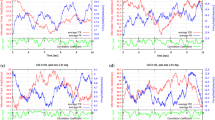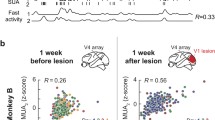Summary
The firing frequency of a population of 213 units in striate and circumstriate cortex of the moderately restrained rabbit was studied under the influence of alternating 1-min periods of darkness versus steady, diffuse, featureless illumination. The intent was to determine whether luxotonic responses, so prominent in striate cortex of primates, are indeed absent in rabbits. Such was the case, there being only transient occurrences in three units where the continuing rate of discharge in darkness was double that in the light. There were, however, much more modest differences in rate of continuing discharge in light versus darkness, and for 46% of the units discharging > 1/s this difference exceeded 10% and/or 1/s. The rate of discharge in any case did not provide a reliable index as to the characteristics of a unit's receptive field in response to patterned visual stimuli. The nature and function of luxotonic activity in primates still not being understood, it cannot be decided whether its absence in rabbits represents a true qualitative or merely a quantitative difference between species.
Similar content being viewed by others
References
Bartlett J. R. (1966) Insulating micro-electrodes by centrifuging. Electroencephalogr Clin Neurophysiol 21: 304–305
Bartlett J R, Doty R W (1974) Response of units in striate cortex of squirrel monkeys to visual and electrical stimuli. J Neurophysiol 37: 621–641
Bousfield J D (1978) Some properties of extrastriate visual units in the cortex of the rabbit. Brain Res 149: 365–378
Bunt Ann H, Hendrickson Anita E, Lund Jennifer S, Lund R D, Fuchs A F (1975) Monkey retinal ganglion cells: morphometric analysis and tracing of axonal projections, with a consideration of the peroxidase technique. J Comp Neurol 164: 265–286
Burns B D, Webb A C (1976) The spontaneous activity of neurones in the cat's cerebral cortex. Proc R Soc Lond B 194: 211–223
Chow K L, Masland R H, Stewart D L (1971) Receptive field characteristics of striate cortical neurons in the rabbit. Brain Res 33: 337–352
Chow K L, Douville A, Mascetti G, Grobstein P (1977) Receptive field characteristics of neurons in a visual area of the rabbit temporal cortex. J Comp Neurol 171: 135–146
DeYoe E A, Bartlett J R (1980) Rarity of luxotonic responses in cortical visual areas of the cat. Exp Brain Res (in press)
Doty R W, Bartlett J R (in press) Protracted stimulation of the brain via metallic electrodes. In: Patterson M M, Kesner R (eds) Electrical stimulation techniques. New York, Academic Press
Fuster J M, Creutzfeldt O D, Straschill M (1965) Intracellular recording of neuronal activity in the visual system. Z Vergl Physiol 49: 605–622
Hubel D H (1959) Single unit activity in striate cortex of unrestrained cats. J Physiol (Lond) 147: 226–238
Jung R (1964) Neuronale Grundlagen des Hell-Dunkelsehens und der Farbwahrnehmung. Ber Dtsch Ophthalmol Ges 66: 69–111
Kayama Y, Riso R R, Bartlett J R, Doty R W (1979) Luxotonic responses of units in macaque striate cortex. J Neurophysiol 42: 1495–1512
Livanov M N (1944) (Russian) Biocurrents in the visual analyzer. Probl Physiol Optics (USSR) 2: 106–123
Lömo T, Mollica A (1962) Activity of single units in the primary optic cortex in the unanesthetized rabbit during visual, acoustic, olfactory, and painful stimulation. Arch Ital Biol 100: 86–120
Riso R R, Brust-Carmona H, Bartlett J R, Doty R W (1979) Receptive field properties of luxotonic units in macaque striate cortex. Soc Neurosci 5: 805
Swadlow H A (1974) Properties of antidromically activated callosal neurons and neurons responsive to callosal input in rabbit binocular cortex. Exp Neurol 43: 424–444
Van Sluyters R C, Stewart D L (1974) Binocular neurons of the rabbit's visual cortex: Receptive field characteristics. Exp Brain Res 19: 166–195
Whishaw I O, Previsich N, Flannigan K P (1978) Tonic immobility in feral and domestic Dutch rabbits (Oryctolagus cuniculus), mountain cottontail (Sylvilagus nuttalli), and whitetail jack-rabbit (Lepus townsendi) as a function of posture. Behav Biol 24: 88–96
Author information
Authors and Affiliations
Additional information
Supported by Grant NS 03606 and Contract 70-2279 from the National Institute of Neurological and Communicative Disorders and Stroke, National Institutes of Health
Deceased November 5, 1978
Rights and permissions
About this article
Cite this article
Kahrilas, P.J., Doty, R.W. & Bartlett, J.R. Failure to find luxotonic responses for single units in visual cortex of the rabbit. Exp Brain Res 39, 11–16 (1980). https://doi.org/10.1007/BF00237064
Received:
Issue Date:
DOI: https://doi.org/10.1007/BF00237064




